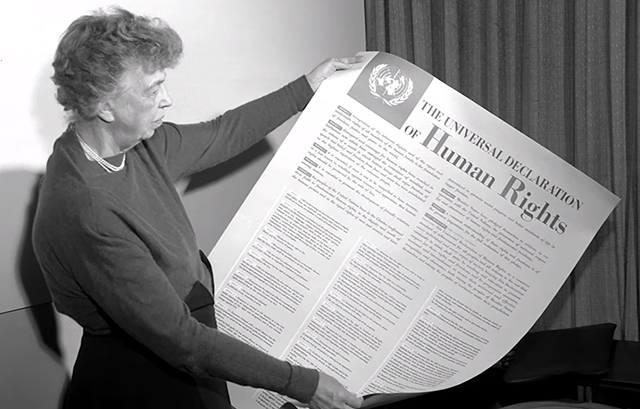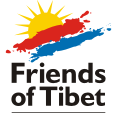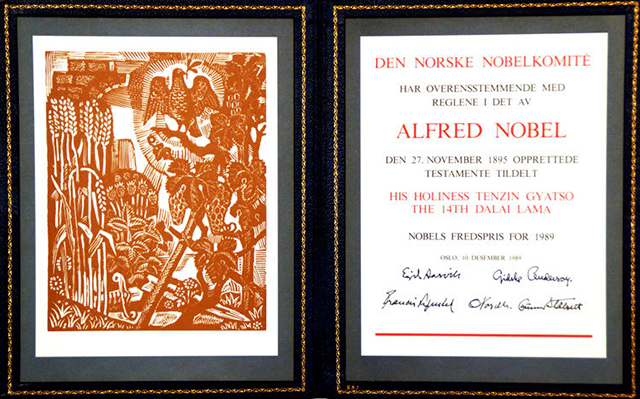| WHY TIBET | WHY BOYCOTT | HUMAN RIGHTS | REPORTS | PHOTOS | VIDEOS | DONORS |
| TIBET FOUNDATION | TIBET RESEARCH |
SRI AUROBINDO ON TIBET | OSHO ON TIBET |
WORLD TIBET DAY |
⋯

Anna Eleanor Roosevelt (1884-1962), American diplomat and activist is the longest-serving First Lady throughout the office terms of her husband — President Franklin D Roosevelt from 1933-1945. Dedicating her life for the underprivileged people of all creeds, races, and nations, she served as the spokeswoman for the United Nations (UN). By the time, Anna Eleanor Roosevelt came to the White House in 1933, she had already understood the social conditions of people better than any of her predecessors and she transformed the role of First Lady accordingly. In 1946, she became the first chairperson of the preliminary United Nations Commission on Human Rights and played a contributory role in drafting the Universal Declaration of Human Rights (UDHR) to be adopted by the General Assembly on December 10, 1948. The vote was unanimous, with eight abstentions: six Soviet Bloc countries as well as South Africa and Saudi Arabia. She awarded the first Human Rights Prizes in 1968 by the UN in recognition of her work. //
DOWNLOAD: (PDF) ↧
THE Universal Declaration of Human Rights, which was adopted by the UN General Assembly on 10 December 1948, was the result of the experience of the Second World War. With the end of that war and the creation of the United Nations, the international community vowed never again to allow atrocities like those of that conflict happen again. World leaders decided to complement the UN Charter with a road map to guarantee the rights of every individual everywhere. The document they considered, and which would later become the Universal Declaration of Human Rights, was taken up at the first session of the General Assembly in 1946.
The Assembly reviewed this draft Declaration on Fundamental Human Rights and Freedoms and transmitted it to the Economic and Social Council "for reference to the Commission on Human Rights for consideration...in its preparation of an international bill of rights." The Commission, at its first session early in 1947, authorised its members to formulate what it termed "a preliminary draft International Bill of Human Rights". Later the work was taken over by a formal drafting committee, consisting of members of the Commission from eight States, selected with due regard for geographical distribution.
The Commission on Human Rights was made up of 18 members from various political, cultural and religious backgrounds. Eleanor Roosevelt, the widow of American President Franklin D Roosevelt, chaired the UDHR drafting committee. With her was René Cassin of France, who composed the first draft of the Declaration, the Committee Rapporteur Charles Malik of Lebanon, Vice-Chairman Peng Chung Chang of China, and John Humphrey of Canada, Director of the UN's Human Rights Division, who prepared the Declaration's blueprint. But Mrs Roosevelt was recognised as the driving force for the Declaration's adoption.
The Commission met for the first time in 1947. In her memoirs, Eleanor Roosevelt recalled: "Dr Chang was a pluralist and held forth in charming fashion on the proposition that there is more than one kind of ultimate reality. The Declaration, he said, should reflect more than simply Western ideas and Dr Humphrey would have to be eclectic in his approach. His remark, though addressed to Dr Humphrey, was really directed at Dr Malik, from whom it drew a prompt retort as he expounded at some length the philosophy of Thomas Aquinas. Dr Humphrey joined enthusiastically in the discussion, and I remember that at one point Dr Chang suggested that the Secretariat might well spend a few months studying the fundamentals of Confucianism!"
The final draft by Cassin was handed to the Commission on Human Rights, which was being held in Geneva. The draft declaration sent out to all UN member States for comments became known as the Geneva Draft.
The first draft of the Declaration was proposed in September 1948 with over 50 Member States participating in the final drafting. By its resolution 217 A (III) of 10 December 1948, the General Assembly, meeting in Paris, adopted the Universal Declaration of Human Rights with eight nations abstaining from the vote but none dissenting. Hernán Santa Cruz of Chile, member of the drafting sub-Committee, wrote:
"I perceived clearly that I was participating in a truly significant historic event in which a consensus had been reached as to the supreme value of the human person, a value that did not originate in the decision of worldly power, but rather in the fact of existing — which gave rise to the inalienable right to live free from want and oppression and to fully develop one's personality. In the Great Hall...there was an atmosphere of genuine solidarity and brotherhood among men and women from all latitudes, the like of which I have not seen again in any international setting."
The entire text of the UDHR was composed in less than two years. At a time when the world was divided into Eastern and Western blocks, finding a common ground on what should make the essence of the document proved to be a colossal task. ◼
United Nations GA Resolution 1353 (XIV) on Tibet (1959) [p.7] UNITED NATIONS GENERAL ASSEMBLY RESOLUTION 1353 (XIV), NEW YORK, 1959
The General Assembly,
Considering that the fundamental human rights and freedoms to which the Tibetan people, like all others, are
entitled include the right to civil and religious liberty for all without distinction,
Mindful also of the distinctive cultural and religious heritage of the people of Tibet and of the autonomy which
they have traditionally enjoyed,
Gravely concerned at reports, including the official statements of His Holiness the Dalai Lama, to the effect
that the fundamental human rights and freedoms of the people of Tibet have been forcibly denied them,
Deploring the effect of these events in increasing international tension and embittering the relations between
peoples at a time when earnest and positive efforts are being made by responsible leaders to reduce tension
and improve international relations,
2. Calls for respect for the fundamental human rights of the Tibetan people and for their distinctive cultural and
religious life. ◼
United Nations GA. Resolution 1723 (XVI) on Tibet (1961) [p.10] UNITED NATIONS GENERAL ASSEMBLY RESOLUTION 1723 (XVI), NEW YORK, 1961
The General Assembly,
Gravely concerned at the continuation of events in Tibet, including the violation of the fundamental human
rights of the Tibetan people and the suppression of the distinctive cultural and religious life which they have
traditionally enjoyed,
Noting with deep anxiety the severe hardships which these events have inflicted on the Tibetan people, as
evidenced by the large-scale exodus of Tibetan refugees to the neighboring countries,
Considering that these events violate fundamental human rights and freedoms set out in the Charter of the
United Nations and the Universal Declaration of Human Rights, including the principle of self-determination of
peoples and nations, and have the deplorable effect of increasing international tension and embittering
relations between peoples,
2) Solemnly renews its call for the cessation of practices which deprive the Tibetan people of their
fundamental human rights and freedoms, including their right to self-determination;
3) Expresses the hope that Member States will make all possible efforts, as appropriate, towards achieving
the purposes of the present resolution. ◼
The General Assembly,
Reaffirming its resolutions 1353 (XIV) of 21 October 1959 and 1723 (XVI) of 20 December 1961 on the
question of Tibet,
Gravely concerned at the continued violation of the fundamental rights and freedoms of the people of Tibet
and the continued suppression of their distinctive cultural and religious life, as evidenced by the exodus of
refugees to the neighboring countries,
2) Reaffirms that the respect for the principles of the Charter of the United Nations and of the Universal
Declaration of Human Rights is essential for the evolution of a peaceful world order based on the rule of law;
3) Declares its conviction that the violation of human rights and fundamental freedoms in Tibet and the
suppression of the distinctive cultural and religious life of its people increased international tension and
embitter relations between peoples;
4) Solemnly renews its call for the cessation of all practices which deprive the Tibetan people of the human
rights and fundamental freedoms which they have always enjoyed;
5) Appeals to all States to use their best endeavors to achieve the purposes of the present resolution. ◼
The Norwegian Nobel Committee has decided to award the 1989 Nobel Peace Prize to the 14th Dalai Lama, Tenzin Gyatso, the religious and political leader of the Tibetan people. The Committee wants to emphasise the fact that the Dalai Lama in his struggle for the liberation of Tibet consistently has opposed the use of violence. He has instead advocated peaceful solutions based upon tolerance and mutual respect in order to preserve the historical and cultural heritage of his people. The Dalai Lama has developed his philosophy of peace from a great reverence for all things living and upon the concept of universal responsibility embracing all mankind as well as nature. In the opinion of the Committee, the Dalai Lama has come forward with constructive and forward-looking proposals for the solution of international conflicts, human rights issues, and global environmental problems.
Oslo, October 5, 1989
His Holiness the XIV Dalai Lama's Acceptance Speech, on the occasion of the award of the Nobel Peace Prize in Oslo, December 10, 1989
Your Majesty, Members of the Nobel Committee, Brothers and Sisters:
I accept the prize with profound gratitude on behalf of the oppressed everywhere and for all those who struggle for freedom and work for world peace. I accept it as a tribute to the man who founded the modern tradition of nonviolent action for change — Mahatma Gandhi — whose life taught and inspired me. And, of course, I accept it on behalf of the six million Tibetan people, my brave countrymen and women inside Tibet, who have suffered and continue to suffer so much. They confront a calculated and systematic strategy aimed at the destruction of their national and cultural identities. The prize reaffirms our conviction that with truth, courage and determination as our weapons, Tibet will be liberated.
No matter what part of the world we come from, we are all basically the same human beings. We all seek happiness and try to avoid suffering. We have the same basic human needs and concerns. All of us human beings want freedom and the right to determine our own destiny as individuals and as peoples. That is human nature. The great changes that are taking place everywhere in the world, from Eastern Europe to Africa, are a clear indication of this.
In China the popular movement for democracy was crushed by brutal force in June this year. But I do not believe the demonstrations were in vain, because the spirit of freedom was rekindled among the Chinese people and China cannot escape the impact of this spirit of freedom sweeping many parts of the world. The brave students and their supporters showed the Chinese leadership and the world the human face of that great nation.
Last week a number of Tibetans were once again sentenced to prison terms of up to nineteen years at a mass show trial, possibly intended to frighten the population before today's event. Their only "crime" was the expression of the widespread desire of Tibetans for the restoration of their beloved country's independence.
The suffering of our people during the past forty years of occupation is well documented. Ours has been a long struggle. We know our cause is just. Because violence can only breed more violence and suffering, our struggle must remain nonviolent and free of hatred. We are trying to end the suffering of our people, not to inflict suffering upon others.
It is with this in mind that I proposed negotiations between Tibet and China on numerous occasions. In 1987, I made specific proposals in a five-point plan for the restoration of peace and human rights in Tibet. This included the conversion of the entire Tibetan plateau into a Zone of Ahimsa, a sanctuary of peace and nonviolence where human beings and nature can live in peace and harmony.
Last year, I elaborated on that plan in Strasbourg, at the European Parliament. I believe the ideas I expressed on those occasions are both realistic and reasonable, although they have been criticised by some of my people as being too conciliatory. Unfortunately, China's leaders have not responded positively to the suggestions we have made, which included important concessions. If this continues we will be compelled to reconsider our position.
Any relationship between Tibet and China will have to be based on the principle of equality, respect, trust and mutual benefit. It will also have to be based on the principle which the wise rulers of Tibet and of China laid down in a treaty as early as 823 A.D., carved on the pillar which still stands today in front of the Jo-khang, Tibet's holiest shrine, in Lhasa, that Tibetans will live happily in the great land of Tibet, and the Chinese will live happily in the great land of China".
As a Buddhist monk, my concern extends to all members of the human family and, indeed, to all sentient beings who suffer. I believe all suffering is caused by ignorance. People inflict pain on others in the selfish pursuit of their happiness or satisfaction. Yet true happiness comes from a sense of inner peace and contentment, which in turn must be achieved through the cultivation of altruism, of love and compassion and elimination of ignorance, selfishness and greed.
The problems we face today, violent conflicts, destruction of nature, poverty, hunger, and so on, are human-created problems which can be resolved through human effort, understanding and the development of a sense of brotherhood and sisterhood. We need to cultivate a universal responsibility for one another and the planet we share. Although I have found my own Buddhist religion helpful in generating love and compassion, even for those we consider our enemies, I am convinced that everyone can develop a good heart and a sense of universal responsibility with or without religion.
With the ever-growing impact of science on our lives, religion and spirituality have a greater role to play by reminding us of our humanity. There is no contradiction between the two. Each gives us valuable insights into the other. Both science and the teachings of the Buddha tell us of the fundamental unity of all things. This understanding is crucial if we are to take positive and decisive action on the pressing global concern with the environment. I believe all religions pursue the same goals, that of cultivating human goodness and bringing happiness to all human beings. Though the means might appear different the ends are the same.
As we enter the final decade of this century I am optimistic that the ancient values that have sustained mankind are today reaffirming themselves to prepare us for a kinder, happier twenty-first century.
I pray for all of us, oppressor and friend, that together we succeed in building a better world through human understanding and love, and that in doing so we may reduce the pain and suffering of all sentient beings.
Thank you.
University Aula, Oslo
Friends of Tibet, PO Box 16674, Mumbai 400050, India.
⋯
Digital Support: Design & People, India + Ibiblio Digital Library & Archive Project, University of North Carolina, USA |

 The Universal Declaration of Human Rights (UDHR) is a milestone document in the history of human rights. Drafted by representatives with different legal and cultural backgrounds from all regions of the world, the Declaration was proclaimed by the United Nations General Assembly in Paris on 10 December 1948 (General Assembly resolution 217 A) as a common standard of achievements for all peoples and all nations. It sets out, for the first time, fundamental human rights to be universally protected and it has been translated into over 500 languages.
The Universal Declaration of Human Rights (UDHR) is a milestone document in the history of human rights. Drafted by representatives with different legal and cultural backgrounds from all regions of the world, the Declaration was proclaimed by the United Nations General Assembly in Paris on 10 December 1948 (General Assembly resolution 217 A) as a common standard of achievements for all peoples and all nations. It sets out, for the first time, fundamental human rights to be universally protected and it has been translated into over 500 languages.
